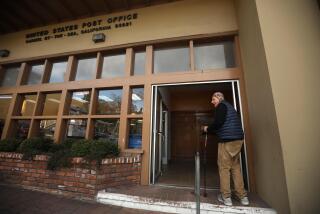N.Y. ‘Vanity Addresses’ Stir Confusion : Location: The craze is part of developers’ efforts to create hot new real estate. But those buildings may be difficult to find.
- Share via
NEW YORK — About a year ago, the apartment dwellers at 44 W. 62nd St. noticed that when they called a taxi, it was often late; that when they ordered Chinese food, it was often cold; that when they expected a package, it was often returned by carrier to the postal depot.
This mischief, they discovered, was caused by a new building next door with a catchy address: 62 W. 62nd.
On the West Side, street numbers ascend from east to west; but No. 62 is east of No. 44--out of sequence--because its developer wanted a symmetrical address and got the authorities to go along.
Some travelers heading west on the street see 62 before reaching 44, erroneously assume they’ve already passed 44, and turn back.
Such confusion is merely one result of developers’ growing ardor for “vanity addresses,” a craze that is filling Manhattan with pretentious-sounding “places” and “plazas” and slapping avenue addresses on buildings tucked away on humble cross streets.
But now the Manhattan borough president’s office has issued new rules designed to quash more imaginative addresses and to impose a more rational view of urban geography.
Before an unusual address is granted, the office must be sure that it will not inconvenience the public or confuse its servants, such as ambulance drivers and firefighters. The applicant must also have a good reason for the special address, not just “a mere assertion of the address’ value in establishing or improving a building’s image.”
Image, and its role in marketing, explains why the era when there was just one Plaza--the one with all the beds--ended more than 20 years ago. Developers were building glass and steel towers that mostly looked alike, so they sought to distinguish their edifices with their addresses.
Barry Lewis, a historian and guide, says that in 1974 a developer “was having trouble leasing space in a new office building at 88 Pine St. So he changed the address to One Wall Street Plaza, which sounds much more impressive.
“But now I start a walking tour there, and I have to spend five minutes telling people where it is.”
Vanity addresses, he complains, negate the predictability of Manhattan’s relentless street grid north of Houston Street.
To most New Yorkers, an address such as 30 W. 34th St. suggests a specific location, almost to the block. About the only clue offered by an address like One New York Plaza, however, is that the building is in New York.
A developer’s lust for a good address is understandable. Location has long been thought to be a Manhattan building’s three most important attributes; a Park Avenue address supposedly is worth an extra $3 to $5 per square foot in monthly rent.
A prestigious address has become even more important with the influx of foreign companies. Perhaps a corporate head in Tokyo would be willing to pay more for space at 200 Park Avenue than at some obscure street number on East 45th Street.
Developers, accordingly, go to some lengths to seem to be in the right place.
A new office tower with “1325 Avenue of the Americas” chiseled into its base is actually on West 53rd Street; actually a good 2 1/2-minute walk from the avenue; actually closer to Seventh Avenue than Avenue of the Americas (which everyone, of course, calls Sixth Avenue). A small sign out at the corner directs the hawk-eyed to the building’s front door.
Another developer wants his planned hotel on 47th Street to be Two Times Square, even though its site is five blocks north of One Times Square, and even though the square on which it sits is named Father Duffy, not Times.
And much confusion probably will attend a building under construction called 1 Broadway Place, which really is in Times Square, but 72 blocks north of 1 Broadway. It will, however, have a real 175 W. 45th St. postal address.
In the case on West 62nd, a judge rejected an attempt to force No. 62 to take a lower street number. So its neighbor has tacked up a white and black “44” sign out at the curb, the latest in a series of attempts to direct limousine drivers, dinner guests and tradespeople into port.
Unfortunately, the sign escapes the notice of a substantial percentage of these people, who reach No. 62 without having seen No. 44 and lose heart. They are not encouraged by the sight of an empty lot nearby.
“Some people just figure the building’s been torn down and say, ‘to hell with it,’ ” says 44’s beleaguered superintendent, Frank Dunnigan.
Dunnigan says he and the doormen “catch it all the time from people who get lost. They blame us , like it was our fault. But we’ve been here 17 years.”
He admits, though, that 62 W. 62nd does have a ring to it.
“It sort of flows off your tongue,” he says. “And it must look good on a business card. Nice and balanced.”
More to Read
Inside the business of entertainment
The Wide Shot brings you news, analysis and insights on everything from streaming wars to production — and what it all means for the future.
You may occasionally receive promotional content from the Los Angeles Times.










